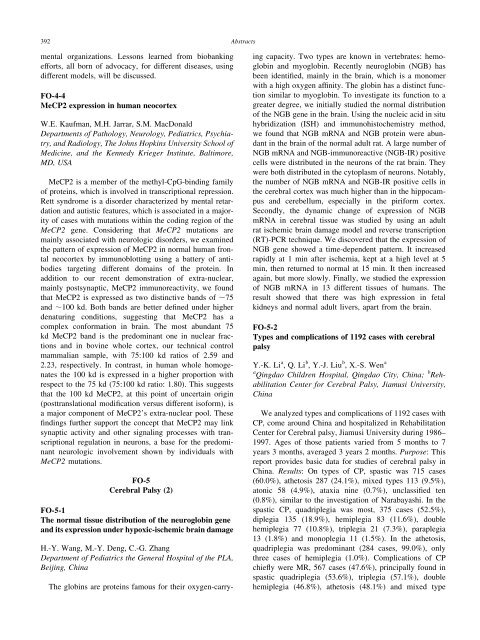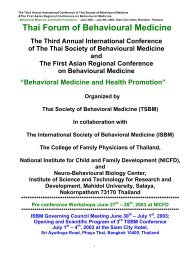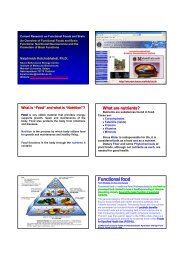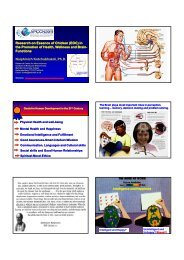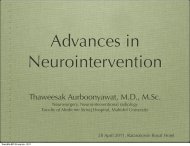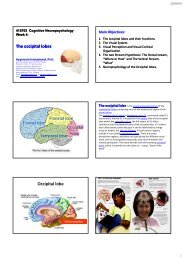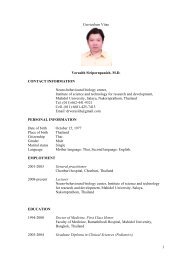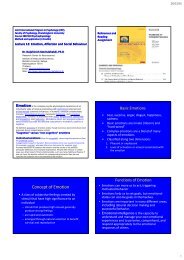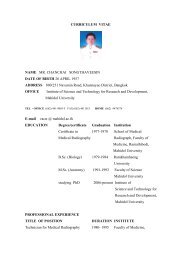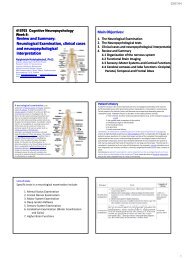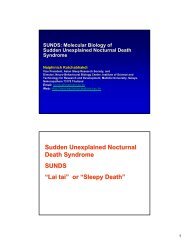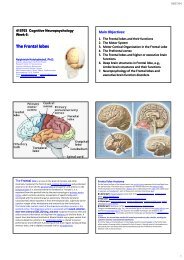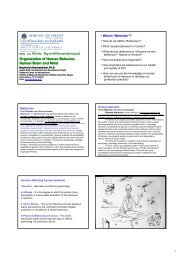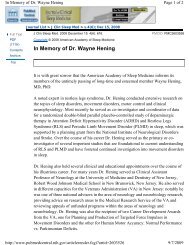PDF File - Mahidol University
PDF File - Mahidol University
PDF File - Mahidol University
Create successful ePaper yourself
Turn your PDF publications into a flip-book with our unique Google optimized e-Paper software.
392<br />
Abstracts<br />
mental organizations. Lessons learned from biobanking<br />
efforts, all born of advocacy, for different diseases, using<br />
different models, will be discussed.<br />
FO-4-4<br />
MeCP2 expression in human neocortex<br />
W.E. Kaufman, M.H. Jarrar, S.M. MacDonald<br />
Departments of Pathology, Neurology, Pediatrics, Psychiatry,<br />
and Radiology, The Johns Hopkins <strong>University</strong> School of<br />
Medicine, and the Kennedy Krieger Institute, Baltimore,<br />
MD, USA<br />
MeCP2 is a member of the methyl-CpG-binding family<br />
of proteins, which is involved in transcriptional repression.<br />
Rett syndrome is a disorder characterized by mental retardation<br />
and autistic features, which is associated in a majority<br />
of cases with mutations within the coding region of the<br />
MeCP2 gene. Considering that MeCP2 mutations are<br />
mainly associated with neurologic disorders, we examined<br />
the pattern of expression of MeCP2 in normal human frontal<br />
neocortex by immunoblotting using a battery of antibodies<br />
targeting different domains of the protein. In<br />
addition to our recent demonstration of extra-nuclear,<br />
mainly postsynaptic, MeCP2 immunoreactivity, we found<br />
that MeCP2 is expressed as two distinctive bands of ,75<br />
and ,100 kd. Both bands are better defined under higher<br />
denaturing conditions, suggesting that MeCP2 has a<br />
complex conformation in brain. The most abundant 75<br />
kd MeCP2 band is the predominant one in nuclear fractions<br />
and in bovine whole cortex, our technical control<br />
mammalian sample, with 75:100 kd ratios of 2.59 and<br />
2.23, respectively. In contrast, in human whole homogenates<br />
the 100 kd is expressed in a higher proportion with<br />
respect to the 75 kd (75:100 kd ratio: 1.80). This suggests<br />
that the 100 kd MeCP2, at this point of uncertain origin<br />
(posttranslational modification versus different isoform), is<br />
a major component of MeCP2’s extra-nuclear pool. These<br />
findings further support the concept that MeCP2 may link<br />
synaptic activity and other signaling processes with transcriptional<br />
regulation in neurons, a base for the predominant<br />
neurologic involvement shown by individuals with<br />
MeCP2 mutations.<br />
FO-5<br />
Cerebral Palsy (2)<br />
FO-5-1<br />
The normal tissue distribution of the neuroglobin gene<br />
and its expression under hypoxic-ischemic brain damage<br />
H.-Y. Wang, M.-Y. Deng, C.-G. Zhang<br />
Department of Pediatrics the General Hospital of the PLA,<br />
Beijing, China<br />
The globins are proteins famous for their oxygen-carrying<br />
capacity. Two types are known in vertebrates: hemoglobin<br />
and myoglobin. Recently neuroglobin (NGB) has<br />
been identified, mainly in the brain, which is a monomer<br />
with a high oxygen affinity. The globin has a distinct function<br />
similar to myoglobin. To investigate its function to a<br />
greater degree, we initially studied the normal distribution<br />
of the NGB gene in the brain. Using the nucleic acid in situ<br />
hybridization (ISH) and immunohistochemistry method,<br />
we found that NGB mRNA and NGB protein were abundant<br />
in the brain of the normal adult rat. A large number of<br />
NGB mRNA and NGB-immunoreactive (NGB-IR) positive<br />
cells were distributed in the neurons of the rat brain. They<br />
were both distributed in the cytoplasm of neurons. Notably,<br />
the number of NGB mRNA and NGB-IR positive cells in<br />
the cerebral cortex was much higher than in the hippocampus<br />
and cerebellum, especially in the piriform cortex.<br />
Secondly, the dynamic change of expression of NGB<br />
mRNA in cerebral tissue was studied by using an adult<br />
rat ischemic brain damage model and reverse transcription<br />
(RT)-PCR technique. We discovered that the expression of<br />
NGB gene showed a time-dependent pattern. It increased<br />
rapidly at 1 min after ischemia, kept at a high level at 5<br />
min, then returned to normal at 15 min. It then increased<br />
again, but more slowly. Finally, we studied the expression<br />
of NGB mRNA in 13 different tissues of humans. The<br />
result showed that there was high expression in fetal<br />
kidneys and normal adult livers, apart from the brain.<br />
FO-5-2<br />
Types and complications of 1192 cases with cerebral<br />
palsy<br />
Y.-K. Li a ,Q.Li b , Y.-J. Liu b , X.-S. Wen a<br />
a Qingdao Children Hospital, Qingdao City, China; b Rehabilitation<br />
Center for Cerebral Palsy, Jiamusi <strong>University</strong>,<br />
China<br />
We analyzed types and complications of 1192 cases with<br />
CP, come around China and hospitalized in Rehabilitation<br />
Center for Cerebral palsy, Jiamusi <strong>University</strong> during 1986–<br />
1997. Ages of those patients varied from 5 months to 7<br />
years 3 months, averaged 3 years 2 months. Purpose: This<br />
report provides basic data for studies of cerebral palsy in<br />
China. Results: On types of CP, spastic was 715 cases<br />
(60.0%), athetosis 287 (24.1%), mixed types 113 (9.5%),<br />
atonic 58 (4.9%), ataxia nine (0.7%), unclassified ten<br />
(0.8%), similar to the investigation of Narabayashi. In the<br />
spastic CP, quadriplegia was most, 375 cases (52.5%),<br />
diplegia 135 (18.9%), hemiplegia 83 (11.6%), double<br />
hemiplegia 77 (10.8%), triplegia 21 (7.3%), paraplegia<br />
13 (1.8%) and monoplegia 11 (1.5%). In the athetosis,<br />
quadriplegia was predominant (284 cases, 99.0%), only<br />
three cases of hemiplegia (1.0%). Complications of CP<br />
chiefly were MR, 567 cases (47.6%), principally found in<br />
spastic quadriplegia (53.6%), triplegia (57.1%), double<br />
hemiplegia (46.8%), athetosis (48.1%) and mixed type


